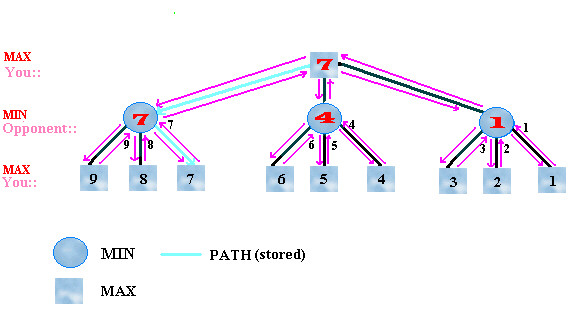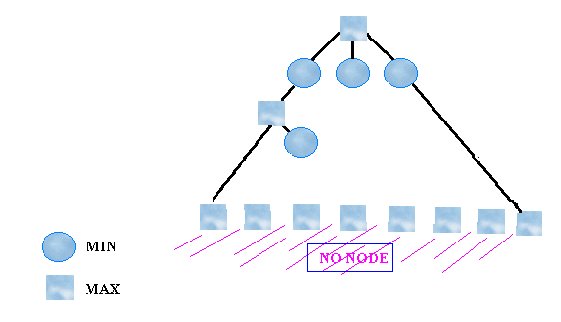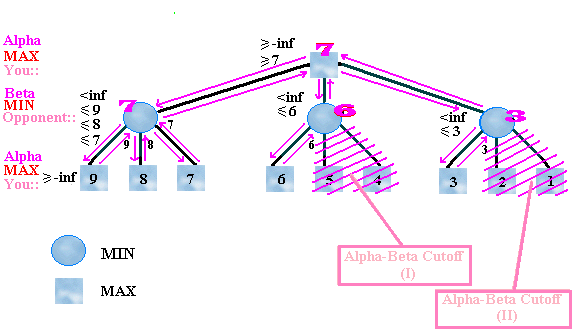
We will set up a framework for playing a two-person game in which the two players alternate making moves.
The game can normally be represented as a tree where the nodes represent the current status of the game and the arcs represent the moves. The game tree consists of all possible moves for the current players starting at the root and all possible moves for the next player as the children of these nodes, and so forth, as far into the future of the game as desired. The leaves of the game tree represent terminal positions as one where the outcome of the game is clear (a win, a loss, a draw, a payoff). Each terminal position has a score. High scores are good. For example, we may associate 1 with a win, 0 with a draw and -1 with a loss.
In this game, several piles of sticks are given. We represent the configuration of the piles by a monotone sequence of integers, such as (1,3,5,7) or (2,2,3,9,110). A player may remove, in one turn, any number of sticks from one pile of his/her choice. Thus, (1,3,5,7) would become (1,1,3,5) if the player were to remove 6 sticks from the last pile. The player who takes the last stick loses. The NIM game (1, 2, 2) can be presented by Fig. 1.

In Figure 1 , the number in the root shows that in the beginning there are five sticks which consists of three sets, 1, 2, 2. Suppose you are the player who makes the first move. You may take one or two sticks. After your move, it is your opponent's turn and the numbers in the nodes represent the sticks left. Then the opponent moves one or two sticks and the status is shown in the next nodes and so on until there is one stick left.
Now, we can use this game tree to analyze the best possible move. For each player, the best move is to make the opponent lose and make himself/herself win. So, one should make the move to get the MAX score and force their opponent to get the MIN score. A loss is presented by "0" and a win is presented by "1". The MAX nodes represent the position of the current player and the MIN nodes represent the position of the opponent. Since the goal of this game is that the player who removes the last stick loses, the scores are assigned to "0" if the leaves are at MAX nodes and the scores are assigned to "1" if the leaves are MIN. Then we back up the scores to assign the internal nodes from the bottom nodes. At MAX nodes, choose the MAXIMUM score of the children; at MIN nodes, choose the MINIMUM score of the children. In this manner, we may compute the scores of the non_leaf nodes from the bottom up. In the example of figure 1, the root node is "1", and thus corresponds to a win for the first player. The first player should pick a child position that corresponds to a "1".
In a MiniMax tree, one can view in its entire form, the score values at each of the levels of the tree at any given point during the game. By viewing this tree, a player may be able to forsee which moves are more advantageous and beneficial for themselves. The root of the tree represents the position of the current player, thus, depending on the number of levels that is to be searched, all odd levels represent the first player while the even levels represent the second player.
In a two player game, the first player moves with MAX score and the second player moves with MIN score. A minimax search is used to determine all possible continuations of the game up to a desired level. A score is originally assigned to the leaf, then by evaluating each possible set of moves, a score is assigned to the upper level by the minimax algorithm. The minimax algorithm performs a preorder traversal and computes the scores on the fly. The same would be obtained by a simple recursive algorithm. The rule is as follows:
Note: If we know the scores of all the nodes, it would be futile and boring to play the game because we would know the outcomes already (against a clever opponent). The scores are the same as the outcome of a game that would result in two infinitely clever players would play each other starting from that position.
The complexity of the algorithm is equal to the number of nodes in the tree.

Figure 2 shows how the minimax algorithm works. There is a game tree which consists of all possible moves. The root represents the current player and the children of the root represents the opponent. And the leaves contains the scores. We want to find the best move for the current player. So at the position of the current player, we choose the MAX score of its children; and at the position of opponent, we choose the MIN score of its children. For MIN Nodes, the score computed starts with +infinity and decreases with time. For MAX nodes, scores starts with -infinity and increases with time.
In large trees, it is quite impossible to search all the nodes. The next best thing is to trim the tree to a few levels and pretend that it is a good approximation of the (unknown) minimax tree by assigning scores to its leaves. The difference now is that the scores are no longer exact, but only educated guesses. The scores obtained in this manner are said to be calculated with the aid of an evaluation function. Evaluation functions are constructed by the user based upon insight and experience. We may still employ the minimax algorithm to compute all the scores:

ALPHA-BETA search is a method that reduces the number of nodes explored in Minimax strategy. It reduces the time required for the search and it must be restricted so that no time is to be wasted searching moves that are obviously bad for the current player. The exact implementation of alpha-beta keeps track of the best move for each side as it moves throughout the tree.
We proceed in the same (preorder) way as for the minimax algorithm. For the MIN nodes, the score computed starts with +infinity and decreases with time. For MAX nodes, scores computed starts with -infinity and increase with time.
The efficiency of the Alpha-Beta procedure depends on the order in which successors of a node are examined. If we were lucky, at a MIN node we would always consider the nodes in order from low to high score and at a MAX node the nodes in order from high to low score. In general it can be shown that in the most favorable circumstances the alpha-beta search opens as many leaves as minimax on a game tree with double its depth.
Here is an example of Alpha-Beta search:

An alpha-beta algorithm consists of two functions: evalutemin and evalutemax. If calling from then MIN nodes, function evalutemin is used; While beginnling from a max node, funcction evalutemax should be required. B is Initialy set as the score bound ( e.g. + infinity).
The following is a simple Java Applet Demo to demonstrate the Minimax search
shown in Fig. 2 .
.
|
|
|
|
|
|
|
|
|
|
|
|
|
|
|
|
|
|
|
|
|
|
|
|
|
|
|
|
|
|
|
|
|